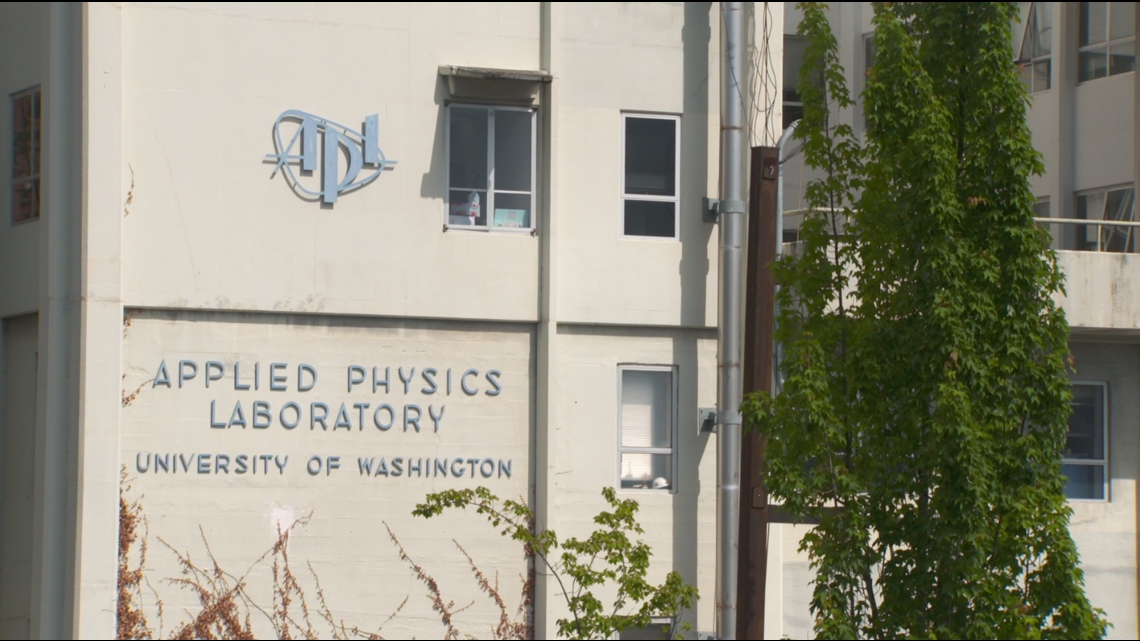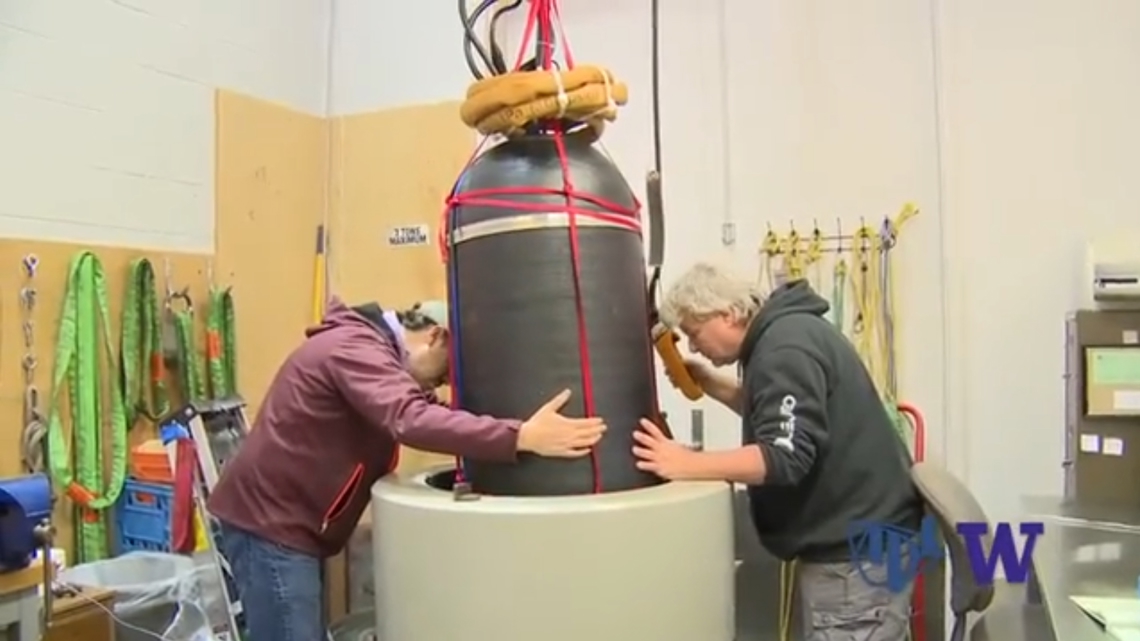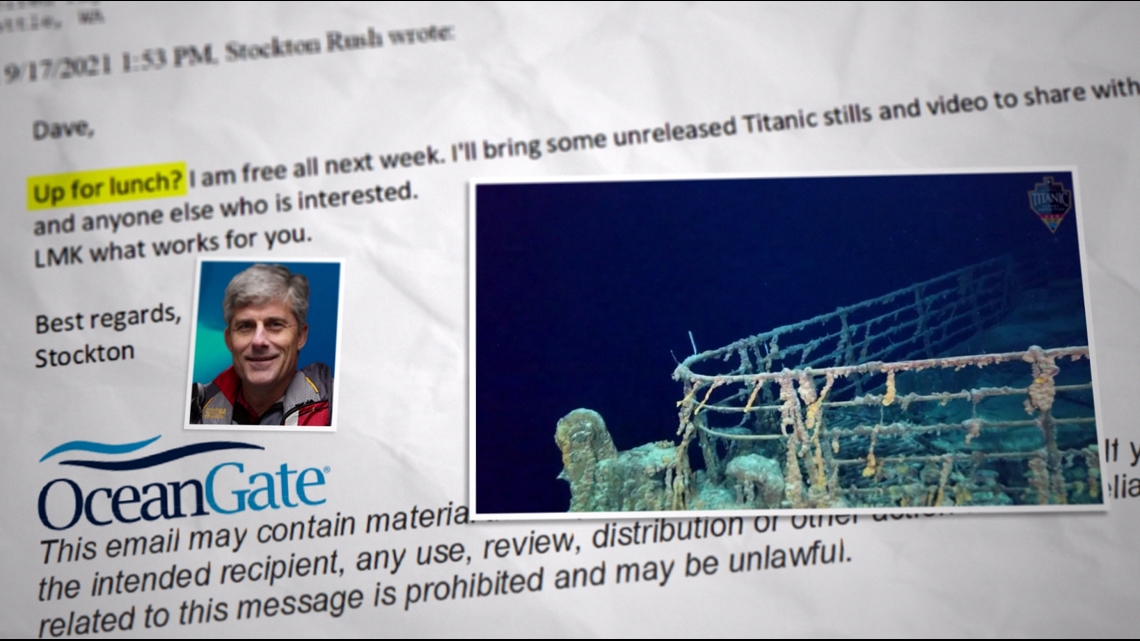SEATTLE — The University of Washington, which last year denied involvement in the Titan submersible that imploded and killed five people on a deep-water plunge to the Titanic, had a role in the early stages of the vessel’s development and its design, university records show.
A KING 5 review of hundreds of UW records reveals the school had a deeper relationship with OceanGate, the Everett company that manufactured the carbon-fiber sub, than it originally told the public in the wake of the Titan disaster.
The records, which include emails, documents, 3D drawings and photographs, shed new light on the school’s years-long collaboration with the company and its CEO, which ranged from cozy to contentious amid disagreements over safety and the Titan’s design. The documents show UW staff had a relationship with OceanGate years before the university said its formal partnership began, and at least one UW engineer kept in touch with the company leader, Stockton Rush, as the Titan completed its first Titanic dives.
One of the university’s lead engineers on the UW-OceanGate project performed an analysis and provided input on the Titan design at OceanGate’s request in 2019, according to emails. Years earlier, he and other UW engineers worked on the development of the carbon-fiber vessel when it was known by a different name, Cyclops 2.
It’s unclear if the work performed by UW staff made it into the final version of the Titan. Emails and phone calls to three of the primary university engineers on the UW-OceanGate contract were not returned.
OceanGate, which was based in Everett, ceased operations last summer following the Titan’s “catastrophic implosion” that killed CEO Rush and four others who were on a journey to the Titanic shipwreck on June 18, 2023.
UW stands by previous statements
Prior to the 2023 tragedy, OceanGate repeatedly touted publicly that its first-of-its-kind Titan vessel was built in collaboration with UW, Boeing and NASA. Rush name-dropped his “partners” to help legitimize the un-classed submersible, made with a carbon fiber-hull and titanium end caps, as he faced scrutiny and criticism that his vessel’s experimental design jeopardized safety.
In response to the Titan disaster, UW issued two statements last year, which distanced the university from the deep-water tragedy that horrified the world.
UW said its Applied Physics Laboratory (APL) “provided engineering services” to OceanGate and Rush from 2013 to 2020 under a $5 million research agreement that “ended with the completion of the shallow-water vessel” called Cyclops 1. It was a less controversial project, as the vessel’s hull was made from steel instead of the carbon fiber used in the Titan. The Cyclops could dive just 500 meters or 1,640 feet — far shallower than the 12,500 feet depth of the Titanic shipwreck.
“Because APL-UW expertise involved only shallow water implementation, the Laboratory was not involved in the design, engineering or testing of the TITAN submersible used in the RMS TITANIC expedition,” wrote Kevin Williams, executive director of the UW Applied Physics Laboratory in a June 20, 2023 statement.


UW claims when it “parted ways” with OceanGate, APL performed just $650,000 worth of work instead of the $5 million it had planned. Separately, the school said, OceanGate rented the School of Oceanography’s pressure testing tanks on a contract basis — performing nine tests between 2016 and 2022, which involved “no UW researchers.”
Victor Balta, a UW spokesperson, said earlier this month the university stands by the information it shared with reporters in June 2023. He declined an interview for this story, citing ongoing investigations.
The U.S. Coast Guard said last week that its Marine Board Investigation into the incident “remains active but will take longer than initially projected to complete.”
UW planned deep-water vessel from the start
The university claimed last year that its Applied Physics Laboratory had expertise in “only shallow water implementation," but that’s not how the school pitched its credentials to OceanGate when it signed on to work with the company.
In a 32-page proposal sent to Rush in November 2012, APL-UW highlighted the college’s broad background in ocean engineering, which it said included developing “fixed and mobile ocean systems” for “deep ocean exploration.” The school also boasted about its experience conducting research in the deep ocean and operating autonomous vehicles on the deep ocean floor.
The APL-UW proposal, which resulted in a February 2013 contract with OceanGate, detailed the school’s plans from the get-go to help OceanGate build a submersible that could explore the deep ocean. The pitch included resumes and bios for the small team of university engineers who would support the Everett company in “the development, construction, launch, recovery, test and analysis of a deep-ocean, manned under-water vehicle.”
Between 2013 and 2016, UW promoted its partnership with OceanGate in press releases, videos and news stories that were published by local and national media outlets across the country. Throughout that time period, UW’s marketing on the “joint venture” described the university’s plans with OceanGate’ to develop an “innovative” five-person carbon-fiber submersible that could dive deeper than the Titanic shipwreck.
In 2016, the university posted an APL-UW branded video that shows Rush and a group in a school testing facility, conducting a pressure test on a one-third scale model of a carbon-fiber submersible called the “Cyclops 2." It was the original name of the vessel OceanGate later renamed the “Titan.”
After the Titan’s disappearance last year, a UW School of Oceanography professor who saw the university’s 2016 video became concerned. He worried that UW’s 2023 statements about the tragedy didn't add up to what he watched online, emails show.
“I am rather concerned that UW media relations statements is misleading,” the professor wrote in a June 21, 2023 email to the director of the School of Oceanography. “While I’m sure that the APL was not involved in constructing the submersible that is now lost, it appears that that collaboration went beyond the 500m Cyclops.”
The university later clarified in the caption of the 2016 promotional video that “APL-UW played a supporting role in the early development of Cyclops 2.” UW also added a disclaimer that video editing “may not fully capture the details of the partnership.”


‘Stockton may blow a gasket’
The story university emails tell is that by 2017, the UW engineers who worked on Cyclops 2 were ready to cut things off. They declined to do any more work on the vessel that would become the Titan because of a disagreement with Rush on an aspect of the design.
In a May 2017 email exchange between three of the core UW engineers on the project, they expressed concern about Rush’s plan to use glass material on a “housing” that would store key Titan equipment outside the sub. They wrote of their worries that the glass material might explode at such extreme ocean depths.
“(OceanGate Industries) is looking to implement an unproven technique on a human-inhabited vehicle. It might be fine - but there is no history of data or testing to back that up,” wrote Pete Brodsky, a UW engineer on the project.
Brodsky added that Rush might “blow a gasket and vent” once they shared their concerns. It’s unclear if OceanGate moved forward with the plan to install glass housings on the sub.
‘He has some ambitious plans’
University emails show in the years after the 2017 disagreement, UW “relaxed its relationship” with OceanGate, but didn’t completely cut ties.
About two years before the Titan would take its first Titanic dive, the leader of the UW partnership, Robert Miyamoto, asked UW’s APL director to bring Rush on to the team as an “affiliate research scientist,” according to the December 2019 email.
Miyamoto pointed out in the request that Rush had previously “contributed to the visibility” of the school.
“He has some ambitious plans to continue development of deep ocean manned submersibles and sees a good connection and opportunity with UW and OceanGate,” Miyamoto wrote.
According to emails, the APL director signed off on Miyamoto's pitch, but it’s unclear if Rush took on the position.
By then, OceanGate had officially named its carbon-fiber submersible the "Titan," and in 2019, the company asked UW engineer Dave Dyer to weigh-in on the Titan design.
Dyer agreed to the request and performed an analysis on several mockups of the Titan’s cross beams, according to a 2019 email thread between Dyer and OceanGate's Director of Engineering, Tony Nissen. Dyer shared advice with Nissen on how using a lightweight metal like titanium would best perform under deep ocean pressure.
Dyer did not respond to KING 5 requests for comment. It’s unclear if the work he or other UW staff performed under the OceanGate contract made it into Titan's final version.
'No effort to sever ties'
As the UW-OceanGate contract was set to expire in 2020, records show, Dyer left the door open for a continued relationship with the company.
In a Dec. 2020 email addressed to Rush, Dyer asked for clarity on whether the CEO wanted to extend the contract.
“We are still very interested in working with OceanGate as the need arises so please don’t take this as an effort to sever ties - would still very much like to help out as best suits OceanGate's needs,” Dyer wrote in the Dec. 24, 2020 email to Rush. “APL is just looking at either closing out the current contract or extending as it makes sense.”
It's unclear if or how Rush responded.
The next fall, in 2021, Rush sent Dyer an email invitation to lunch.
According to the email, the CEO had just returned from one of his first Titanic dives in the Titan. Rush hoped to share his pictures and video of the famous shipwreck.
Two years later, a similar journey in the Titan would take Rush's life.



